Advantages of Critical Reflection in Early Childhood Settings Explored
VerifiedAdded on 2023/06/07
|10
|2654
|164
Essay
AI Summary
This essay delves into the significance of critical reflection in early childhood settings, emphasizing its role in fostering intellectual and emotional development in young children. It highlights how reflective practices enable children to articulate questions, challenge biases, and analyze cause-and-effect relationships, ultimately leading to deeper learning experiences. The essay also addresses the importance of creating inclusive and supportive environments, particularly in multicultural settings like Australia, where educators must consider the diverse needs of children from various cultural backgrounds. By incorporating critical reflection, educators can enhance children's problem-solving skills, promote positive social interactions, and ensure that all children feel valued and respected within the classroom, contributing to their overall well-being and academic success. The paper references key readings and frameworks, including the National Early Childhood Development Strategy and the Australian framework, Belonging, Being and Becoming, to support its arguments.
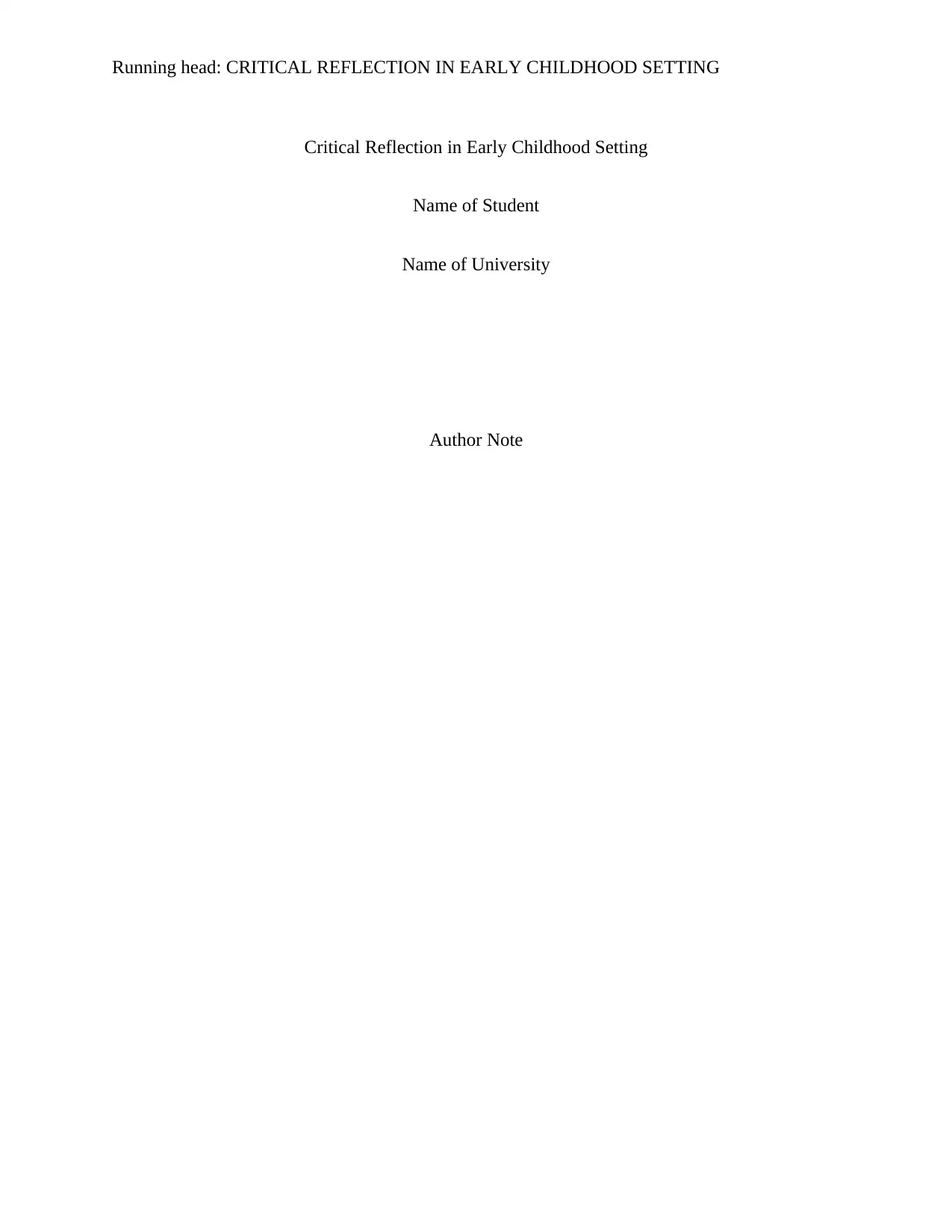
Running head: CRITICAL REFLECTION IN EARLY CHILDHOOD SETTING
Critical Reflection in Early Childhood Setting
Name of Student
Name of University
Author Note
Critical Reflection in Early Childhood Setting
Name of Student
Name of University
Author Note
Paraphrase This Document
Need a fresh take? Get an instant paraphrase of this document with our AI Paraphraser
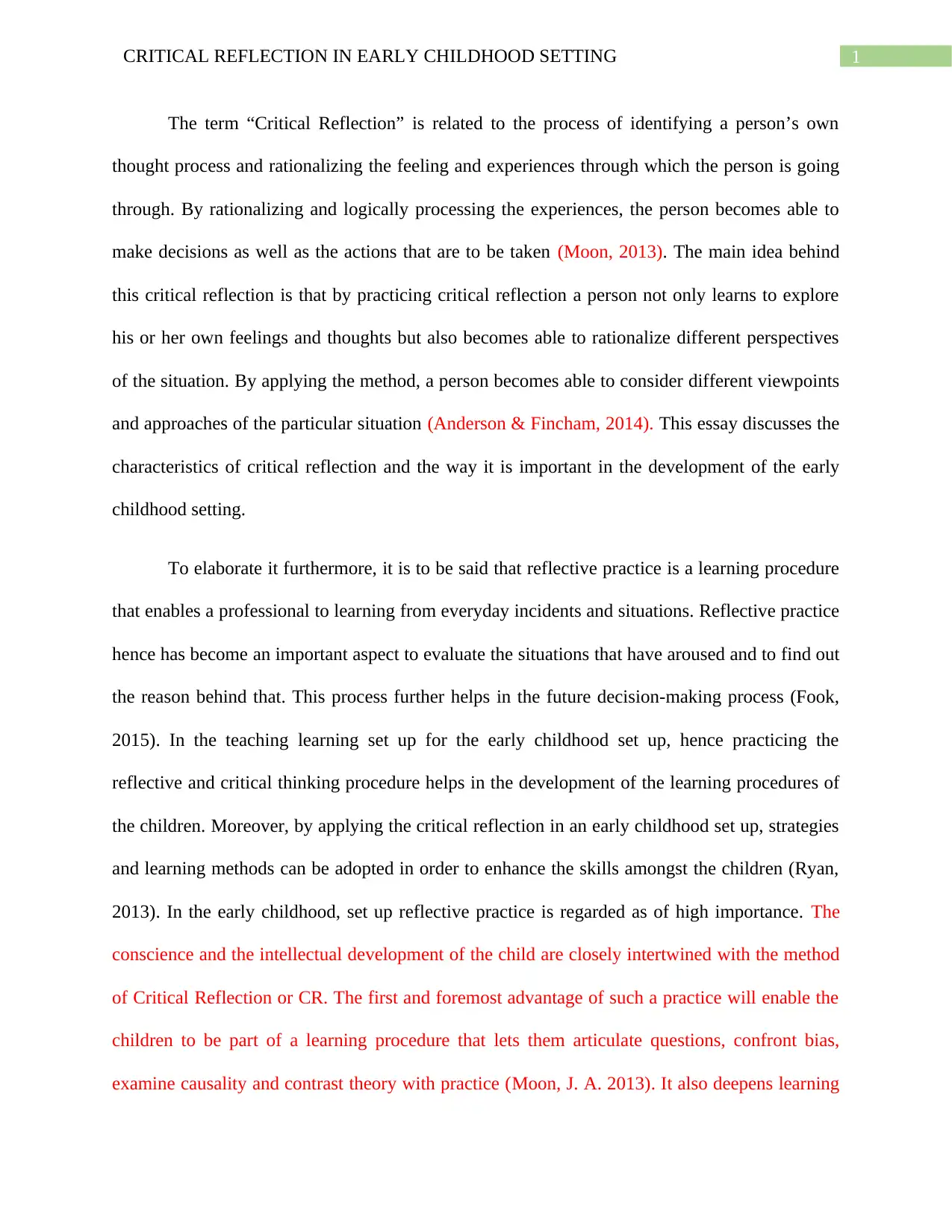
1CRITICAL REFLECTION IN EARLY CHILDHOOD SETTING
The term “Critical Reflection” is related to the process of identifying a person’s own
thought process and rationalizing the feeling and experiences through which the person is going
through. By rationalizing and logically processing the experiences, the person becomes able to
make decisions as well as the actions that are to be taken (Moon, 2013). The main idea behind
this critical reflection is that by practicing critical reflection a person not only learns to explore
his or her own feelings and thoughts but also becomes able to rationalize different perspectives
of the situation. By applying the method, a person becomes able to consider different viewpoints
and approaches of the particular situation (Anderson & Fincham, 2014). This essay discusses the
characteristics of critical reflection and the way it is important in the development of the early
childhood setting.
To elaborate it furthermore, it is to be said that reflective practice is a learning procedure
that enables a professional to learning from everyday incidents and situations. Reflective practice
hence has become an important aspect to evaluate the situations that have aroused and to find out
the reason behind that. This process further helps in the future decision-making process (Fook,
2015). In the teaching learning set up for the early childhood set up, hence practicing the
reflective and critical thinking procedure helps in the development of the learning procedures of
the children. Moreover, by applying the critical reflection in an early childhood set up, strategies
and learning methods can be adopted in order to enhance the skills amongst the children (Ryan,
2013). In the early childhood, set up reflective practice is regarded as of high importance. The
conscience and the intellectual development of the child are closely intertwined with the method
of Critical Reflection or CR. The first and foremost advantage of such a practice will enable the
children to be part of a learning procedure that lets them articulate questions, confront bias,
examine causality and contrast theory with practice (Moon, J. A. 2013). It also deepens learning
The term “Critical Reflection” is related to the process of identifying a person’s own
thought process and rationalizing the feeling and experiences through which the person is going
through. By rationalizing and logically processing the experiences, the person becomes able to
make decisions as well as the actions that are to be taken (Moon, 2013). The main idea behind
this critical reflection is that by practicing critical reflection a person not only learns to explore
his or her own feelings and thoughts but also becomes able to rationalize different perspectives
of the situation. By applying the method, a person becomes able to consider different viewpoints
and approaches of the particular situation (Anderson & Fincham, 2014). This essay discusses the
characteristics of critical reflection and the way it is important in the development of the early
childhood setting.
To elaborate it furthermore, it is to be said that reflective practice is a learning procedure
that enables a professional to learning from everyday incidents and situations. Reflective practice
hence has become an important aspect to evaluate the situations that have aroused and to find out
the reason behind that. This process further helps in the future decision-making process (Fook,
2015). In the teaching learning set up for the early childhood set up, hence practicing the
reflective and critical thinking procedure helps in the development of the learning procedures of
the children. Moreover, by applying the critical reflection in an early childhood set up, strategies
and learning methods can be adopted in order to enhance the skills amongst the children (Ryan,
2013). In the early childhood, set up reflective practice is regarded as of high importance. The
conscience and the intellectual development of the child are closely intertwined with the method
of Critical Reflection or CR. The first and foremost advantage of such a practice will enable the
children to be part of a learning procedure that lets them articulate questions, confront bias,
examine causality and contrast theory with practice (Moon, J. A. 2013). It also deepens learning
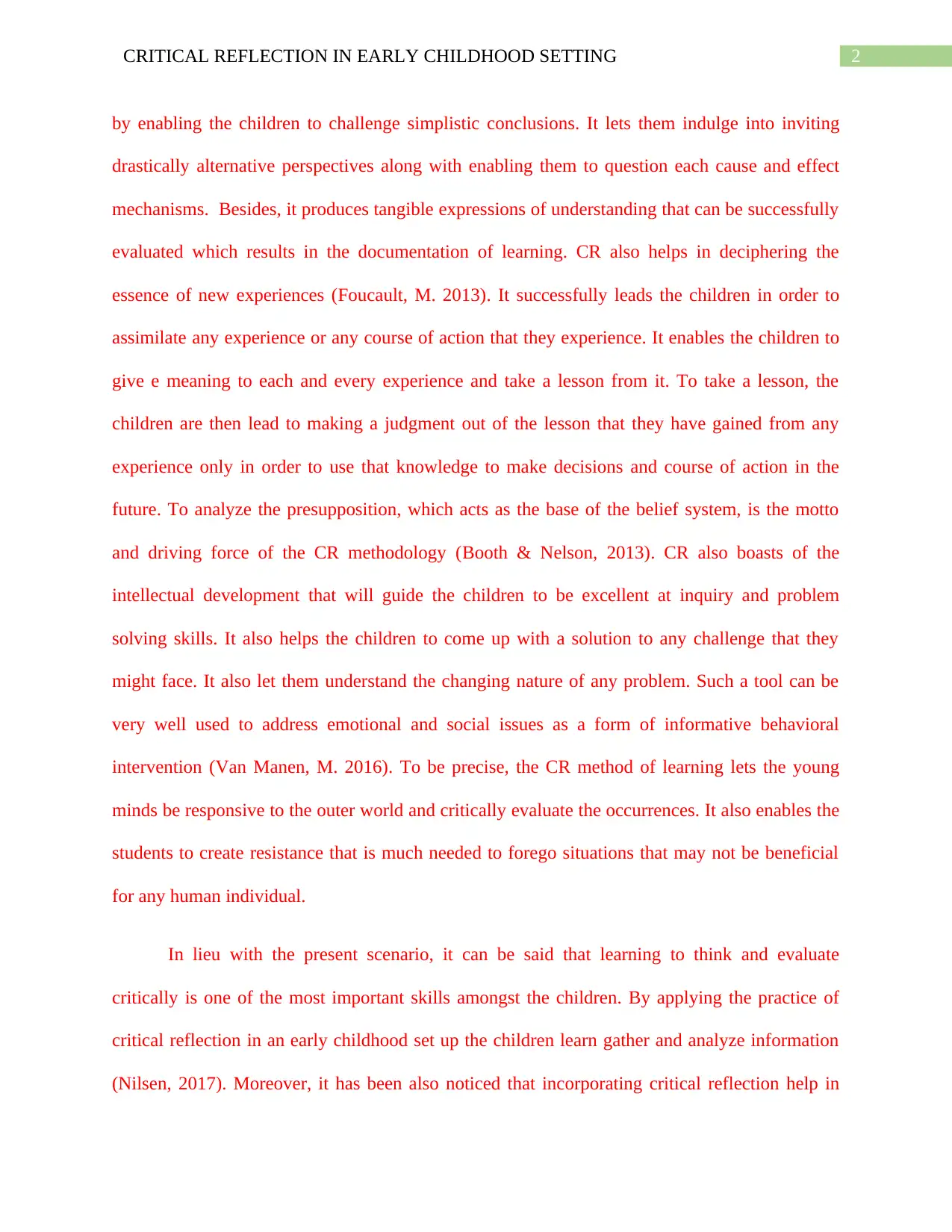
2CRITICAL REFLECTION IN EARLY CHILDHOOD SETTING
by enabling the children to challenge simplistic conclusions. It lets them indulge into inviting
drastically alternative perspectives along with enabling them to question each cause and effect
mechanisms. Besides, it produces tangible expressions of understanding that can be successfully
evaluated which results in the documentation of learning. CR also helps in deciphering the
essence of new experiences (Foucault, M. 2013). It successfully leads the children in order to
assimilate any experience or any course of action that they experience. It enables the children to
give e meaning to each and every experience and take a lesson from it. To take a lesson, the
children are then lead to making a judgment out of the lesson that they have gained from any
experience only in order to use that knowledge to make decisions and course of action in the
future. To analyze the presupposition, which acts as the base of the belief system, is the motto
and driving force of the CR methodology (Booth & Nelson, 2013). CR also boasts of the
intellectual development that will guide the children to be excellent at inquiry and problem
solving skills. It also helps the children to come up with a solution to any challenge that they
might face. It also let them understand the changing nature of any problem. Such a tool can be
very well used to address emotional and social issues as a form of informative behavioral
intervention (Van Manen, M. 2016). To be precise, the CR method of learning lets the young
minds be responsive to the outer world and critically evaluate the occurrences. It also enables the
students to create resistance that is much needed to forego situations that may not be beneficial
for any human individual.
In lieu with the present scenario, it can be said that learning to think and evaluate
critically is one of the most important skills amongst the children. By applying the practice of
critical reflection in an early childhood set up the children learn gather and analyze information
(Nilsen, 2017). Moreover, it has been also noticed that incorporating critical reflection help in
by enabling the children to challenge simplistic conclusions. It lets them indulge into inviting
drastically alternative perspectives along with enabling them to question each cause and effect
mechanisms. Besides, it produces tangible expressions of understanding that can be successfully
evaluated which results in the documentation of learning. CR also helps in deciphering the
essence of new experiences (Foucault, M. 2013). It successfully leads the children in order to
assimilate any experience or any course of action that they experience. It enables the children to
give e meaning to each and every experience and take a lesson from it. To take a lesson, the
children are then lead to making a judgment out of the lesson that they have gained from any
experience only in order to use that knowledge to make decisions and course of action in the
future. To analyze the presupposition, which acts as the base of the belief system, is the motto
and driving force of the CR methodology (Booth & Nelson, 2013). CR also boasts of the
intellectual development that will guide the children to be excellent at inquiry and problem
solving skills. It also helps the children to come up with a solution to any challenge that they
might face. It also let them understand the changing nature of any problem. Such a tool can be
very well used to address emotional and social issues as a form of informative behavioral
intervention (Van Manen, M. 2016). To be precise, the CR method of learning lets the young
minds be responsive to the outer world and critically evaluate the occurrences. It also enables the
students to create resistance that is much needed to forego situations that may not be beneficial
for any human individual.
In lieu with the present scenario, it can be said that learning to think and evaluate
critically is one of the most important skills amongst the children. By applying the practice of
critical reflection in an early childhood set up the children learn gather and analyze information
(Nilsen, 2017). Moreover, it has been also noticed that incorporating critical reflection help in
⊘ This is a preview!⊘
Do you want full access?
Subscribe today to unlock all pages.

Trusted by 1+ million students worldwide
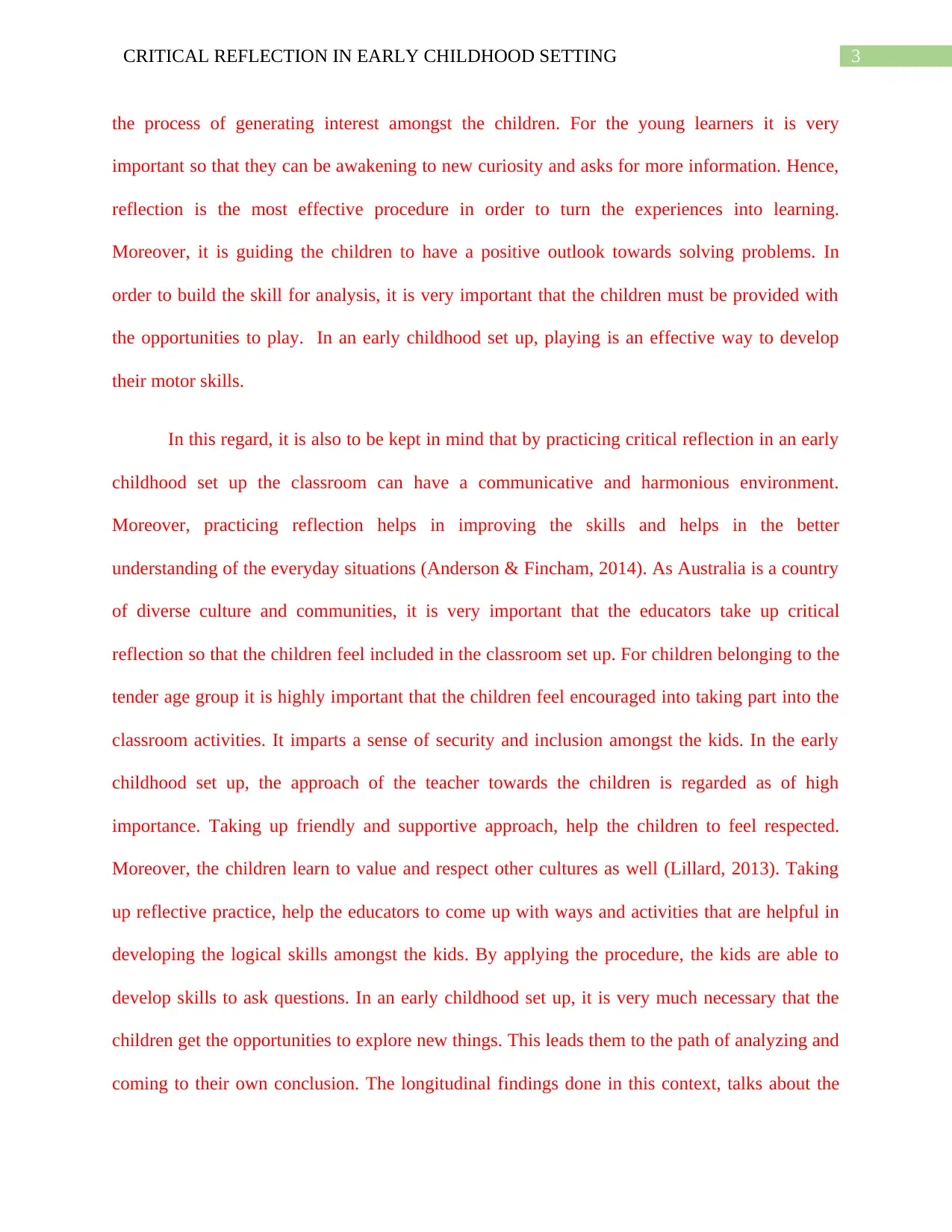
3CRITICAL REFLECTION IN EARLY CHILDHOOD SETTING
the process of generating interest amongst the children. For the young learners it is very
important so that they can be awakening to new curiosity and asks for more information. Hence,
reflection is the most effective procedure in order to turn the experiences into learning.
Moreover, it is guiding the children to have a positive outlook towards solving problems. In
order to build the skill for analysis, it is very important that the children must be provided with
the opportunities to play. In an early childhood set up, playing is an effective way to develop
their motor skills.
In this regard, it is also to be kept in mind that by practicing critical reflection in an early
childhood set up the classroom can have a communicative and harmonious environment.
Moreover, practicing reflection helps in improving the skills and helps in the better
understanding of the everyday situations (Anderson & Fincham, 2014). As Australia is a country
of diverse culture and communities, it is very important that the educators take up critical
reflection so that the children feel included in the classroom set up. For children belonging to the
tender age group it is highly important that the children feel encouraged into taking part into the
classroom activities. It imparts a sense of security and inclusion amongst the kids. In the early
childhood set up, the approach of the teacher towards the children is regarded as of high
importance. Taking up friendly and supportive approach, help the children to feel respected.
Moreover, the children learn to value and respect other cultures as well (Lillard, 2013). Taking
up reflective practice, help the educators to come up with ways and activities that are helpful in
developing the logical skills amongst the kids. By applying the procedure, the kids are able to
develop skills to ask questions. In an early childhood set up, it is very much necessary that the
children get the opportunities to explore new things. This leads them to the path of analyzing and
coming to their own conclusion. The longitudinal findings done in this context, talks about the
the process of generating interest amongst the children. For the young learners it is very
important so that they can be awakening to new curiosity and asks for more information. Hence,
reflection is the most effective procedure in order to turn the experiences into learning.
Moreover, it is guiding the children to have a positive outlook towards solving problems. In
order to build the skill for analysis, it is very important that the children must be provided with
the opportunities to play. In an early childhood set up, playing is an effective way to develop
their motor skills.
In this regard, it is also to be kept in mind that by practicing critical reflection in an early
childhood set up the classroom can have a communicative and harmonious environment.
Moreover, practicing reflection helps in improving the skills and helps in the better
understanding of the everyday situations (Anderson & Fincham, 2014). As Australia is a country
of diverse culture and communities, it is very important that the educators take up critical
reflection so that the children feel included in the classroom set up. For children belonging to the
tender age group it is highly important that the children feel encouraged into taking part into the
classroom activities. It imparts a sense of security and inclusion amongst the kids. In the early
childhood set up, the approach of the teacher towards the children is regarded as of high
importance. Taking up friendly and supportive approach, help the children to feel respected.
Moreover, the children learn to value and respect other cultures as well (Lillard, 2013). Taking
up reflective practice, help the educators to come up with ways and activities that are helpful in
developing the logical skills amongst the kids. By applying the procedure, the kids are able to
develop skills to ask questions. In an early childhood set up, it is very much necessary that the
children get the opportunities to explore new things. This leads them to the path of analyzing and
coming to their own conclusion. The longitudinal findings done in this context, talks about the
Paraphrase This Document
Need a fresh take? Get an instant paraphrase of this document with our AI Paraphraser
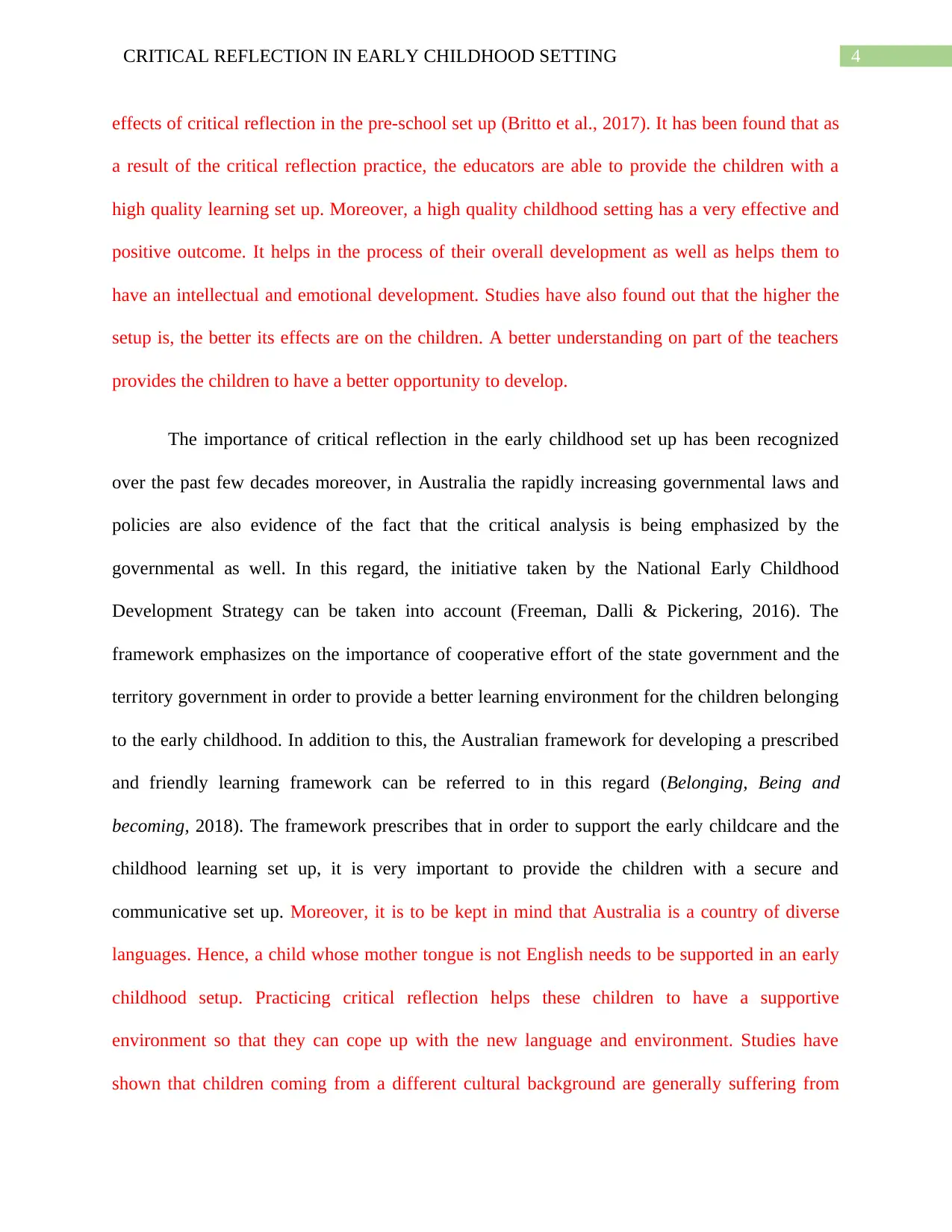
4CRITICAL REFLECTION IN EARLY CHILDHOOD SETTING
effects of critical reflection in the pre-school set up (Britto et al., 2017). It has been found that as
a result of the critical reflection practice, the educators are able to provide the children with a
high quality learning set up. Moreover, a high quality childhood setting has a very effective and
positive outcome. It helps in the process of their overall development as well as helps them to
have an intellectual and emotional development. Studies have also found out that the higher the
setup is, the better its effects are on the children. A better understanding on part of the teachers
provides the children to have a better opportunity to develop.
The importance of critical reflection in the early childhood set up has been recognized
over the past few decades moreover, in Australia the rapidly increasing governmental laws and
policies are also evidence of the fact that the critical analysis is being emphasized by the
governmental as well. In this regard, the initiative taken by the National Early Childhood
Development Strategy can be taken into account (Freeman, Dalli & Pickering, 2016). The
framework emphasizes on the importance of cooperative effort of the state government and the
territory government in order to provide a better learning environment for the children belonging
to the early childhood. In addition to this, the Australian framework for developing a prescribed
and friendly learning framework can be referred to in this regard (Belonging, Being and
becoming, 2018). The framework prescribes that in order to support the early childcare and the
childhood learning set up, it is very important to provide the children with a secure and
communicative set up. Moreover, it is to be kept in mind that Australia is a country of diverse
languages. Hence, a child whose mother tongue is not English needs to be supported in an early
childhood setup. Practicing critical reflection helps these children to have a supportive
environment so that they can cope up with the new language and environment. Studies have
shown that children coming from a different cultural background are generally suffering from
effects of critical reflection in the pre-school set up (Britto et al., 2017). It has been found that as
a result of the critical reflection practice, the educators are able to provide the children with a
high quality learning set up. Moreover, a high quality childhood setting has a very effective and
positive outcome. It helps in the process of their overall development as well as helps them to
have an intellectual and emotional development. Studies have also found out that the higher the
setup is, the better its effects are on the children. A better understanding on part of the teachers
provides the children to have a better opportunity to develop.
The importance of critical reflection in the early childhood set up has been recognized
over the past few decades moreover, in Australia the rapidly increasing governmental laws and
policies are also evidence of the fact that the critical analysis is being emphasized by the
governmental as well. In this regard, the initiative taken by the National Early Childhood
Development Strategy can be taken into account (Freeman, Dalli & Pickering, 2016). The
framework emphasizes on the importance of cooperative effort of the state government and the
territory government in order to provide a better learning environment for the children belonging
to the early childhood. In addition to this, the Australian framework for developing a prescribed
and friendly learning framework can be referred to in this regard (Belonging, Being and
becoming, 2018). The framework prescribes that in order to support the early childcare and the
childhood learning set up, it is very important to provide the children with a secure and
communicative set up. Moreover, it is to be kept in mind that Australia is a country of diverse
languages. Hence, a child whose mother tongue is not English needs to be supported in an early
childhood setup. Practicing critical reflection helps these children to have a supportive
environment so that they can cope up with the new language and environment. Studies have
shown that children coming from a different cultural background are generally suffering from
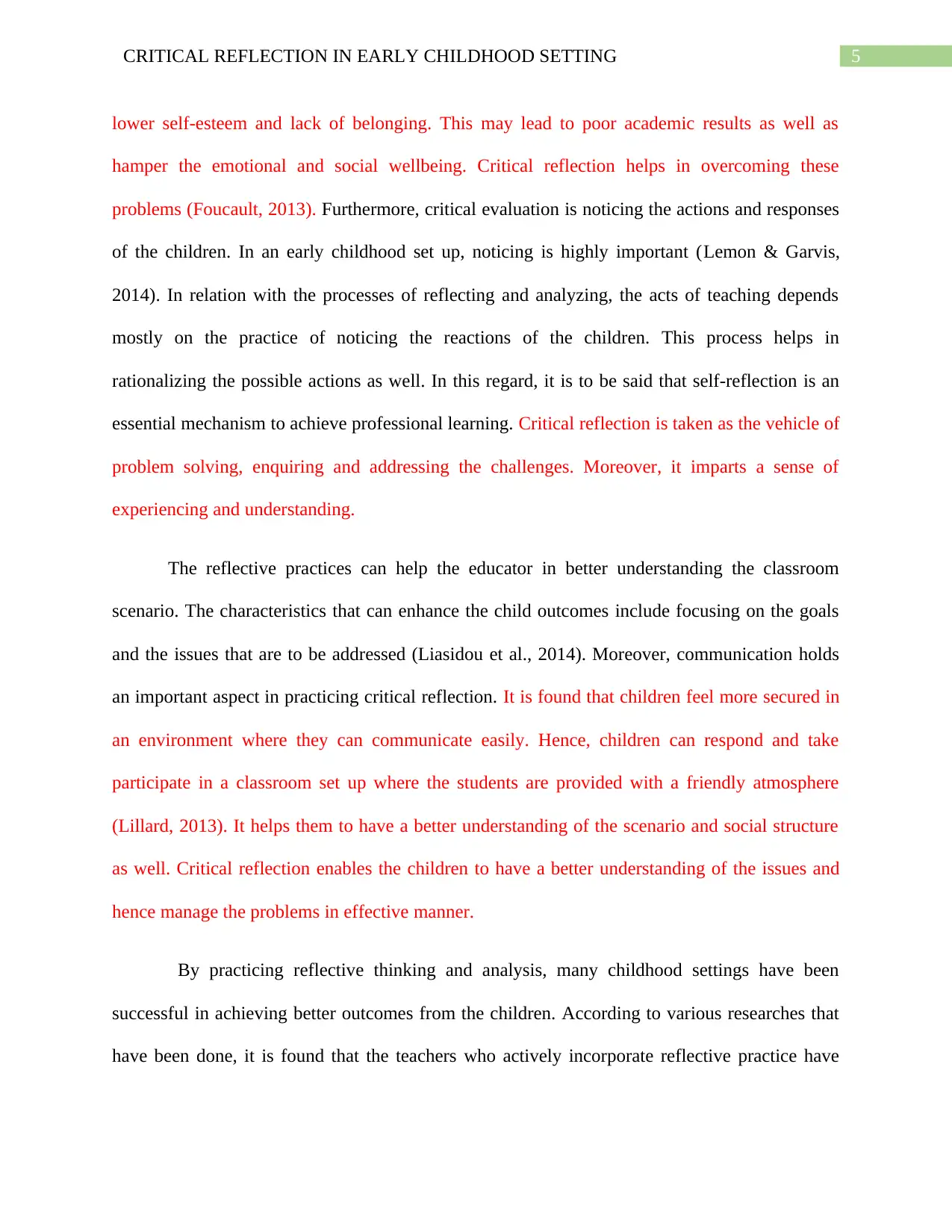
5CRITICAL REFLECTION IN EARLY CHILDHOOD SETTING
lower self-esteem and lack of belonging. This may lead to poor academic results as well as
hamper the emotional and social wellbeing. Critical reflection helps in overcoming these
problems (Foucault, 2013). Furthermore, critical evaluation is noticing the actions and responses
of the children. In an early childhood set up, noticing is highly important (Lemon & Garvis,
2014). In relation with the processes of reflecting and analyzing, the acts of teaching depends
mostly on the practice of noticing the reactions of the children. This process helps in
rationalizing the possible actions as well. In this regard, it is to be said that self-reflection is an
essential mechanism to achieve professional learning. Critical reflection is taken as the vehicle of
problem solving, enquiring and addressing the challenges. Moreover, it imparts a sense of
experiencing and understanding.
The reflective practices can help the educator in better understanding the classroom
scenario. The characteristics that can enhance the child outcomes include focusing on the goals
and the issues that are to be addressed (Liasidou et al., 2014). Moreover, communication holds
an important aspect in practicing critical reflection. It is found that children feel more secured in
an environment where they can communicate easily. Hence, children can respond and take
participate in a classroom set up where the students are provided with a friendly atmosphere
(Lillard, 2013). It helps them to have a better understanding of the scenario and social structure
as well. Critical reflection enables the children to have a better understanding of the issues and
hence manage the problems in effective manner.
By practicing reflective thinking and analysis, many childhood settings have been
successful in achieving better outcomes from the children. According to various researches that
have been done, it is found that the teachers who actively incorporate reflective practice have
lower self-esteem and lack of belonging. This may lead to poor academic results as well as
hamper the emotional and social wellbeing. Critical reflection helps in overcoming these
problems (Foucault, 2013). Furthermore, critical evaluation is noticing the actions and responses
of the children. In an early childhood set up, noticing is highly important (Lemon & Garvis,
2014). In relation with the processes of reflecting and analyzing, the acts of teaching depends
mostly on the practice of noticing the reactions of the children. This process helps in
rationalizing the possible actions as well. In this regard, it is to be said that self-reflection is an
essential mechanism to achieve professional learning. Critical reflection is taken as the vehicle of
problem solving, enquiring and addressing the challenges. Moreover, it imparts a sense of
experiencing and understanding.
The reflective practices can help the educator in better understanding the classroom
scenario. The characteristics that can enhance the child outcomes include focusing on the goals
and the issues that are to be addressed (Liasidou et al., 2014). Moreover, communication holds
an important aspect in practicing critical reflection. It is found that children feel more secured in
an environment where they can communicate easily. Hence, children can respond and take
participate in a classroom set up where the students are provided with a friendly atmosphere
(Lillard, 2013). It helps them to have a better understanding of the scenario and social structure
as well. Critical reflection enables the children to have a better understanding of the issues and
hence manage the problems in effective manner.
By practicing reflective thinking and analysis, many childhood settings have been
successful in achieving better outcomes from the children. According to various researches that
have been done, it is found that the teachers who actively incorporate reflective practice have
⊘ This is a preview!⊘
Do you want full access?
Subscribe today to unlock all pages.

Trusted by 1+ million students worldwide
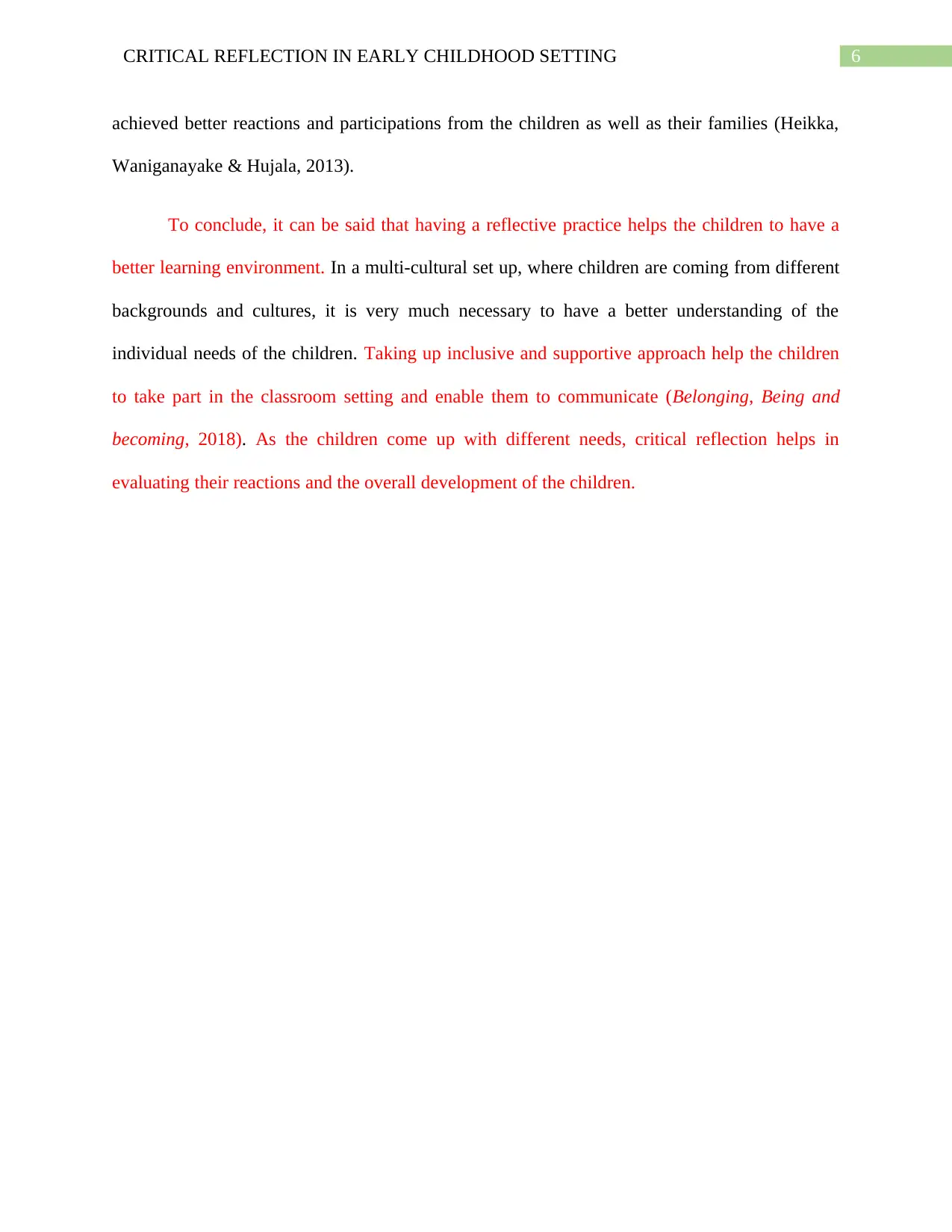
6CRITICAL REFLECTION IN EARLY CHILDHOOD SETTING
achieved better reactions and participations from the children as well as their families (Heikka,
Waniganayake & Hujala, 2013).
To conclude, it can be said that having a reflective practice helps the children to have a
better learning environment. In a multi-cultural set up, where children are coming from different
backgrounds and cultures, it is very much necessary to have a better understanding of the
individual needs of the children. Taking up inclusive and supportive approach help the children
to take part in the classroom setting and enable them to communicate (Belonging, Being and
becoming, 2018). As the children come up with different needs, critical reflection helps in
evaluating their reactions and the overall development of the children.
achieved better reactions and participations from the children as well as their families (Heikka,
Waniganayake & Hujala, 2013).
To conclude, it can be said that having a reflective practice helps the children to have a
better learning environment. In a multi-cultural set up, where children are coming from different
backgrounds and cultures, it is very much necessary to have a better understanding of the
individual needs of the children. Taking up inclusive and supportive approach help the children
to take part in the classroom setting and enable them to communicate (Belonging, Being and
becoming, 2018). As the children come up with different needs, critical reflection helps in
evaluating their reactions and the overall development of the children.
Paraphrase This Document
Need a fresh take? Get an instant paraphrase of this document with our AI Paraphraser
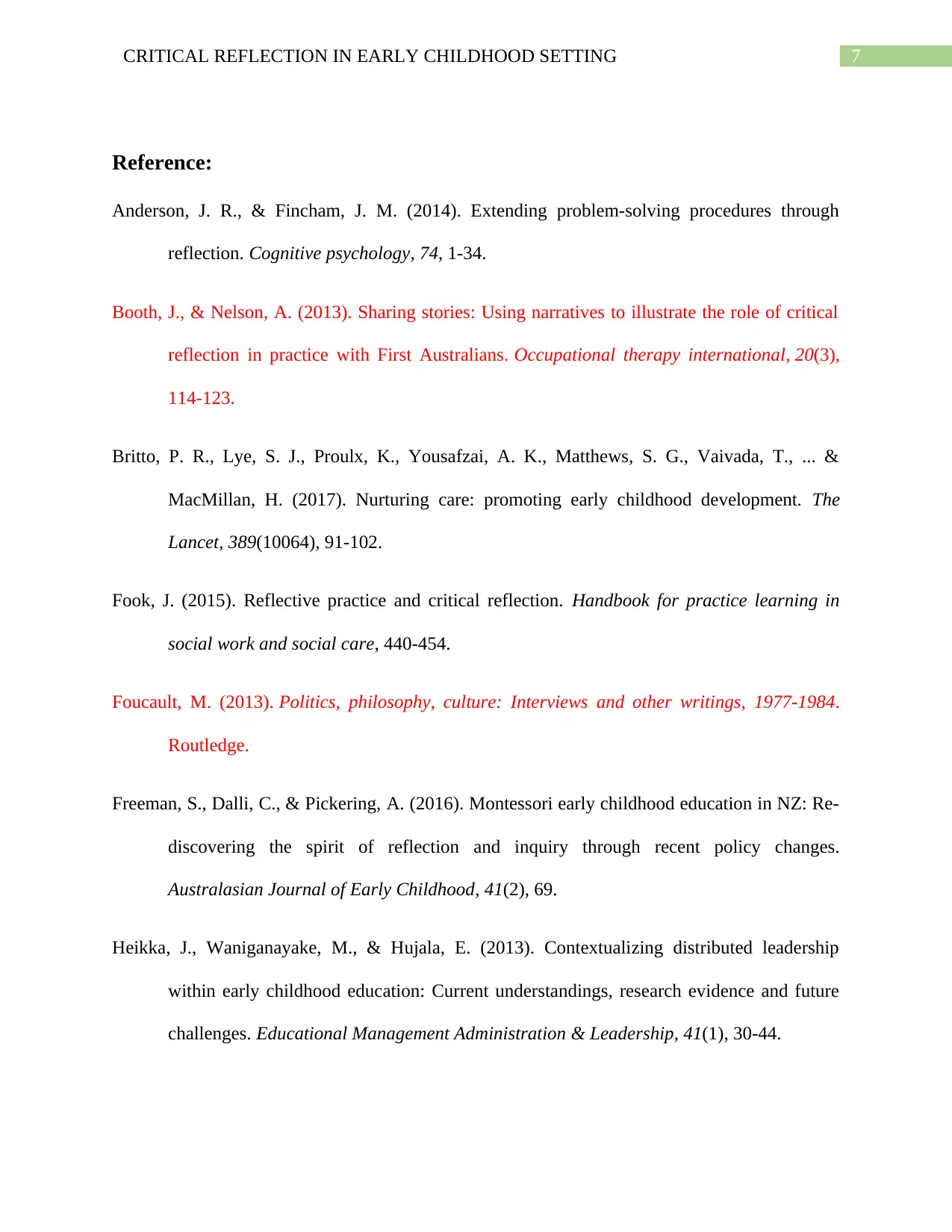
7CRITICAL REFLECTION IN EARLY CHILDHOOD SETTING
Reference:
Anderson, J. R., & Fincham, J. M. (2014). Extending problem-solving procedures through
reflection. Cognitive psychology, 74, 1-34.
Booth, J., & Nelson, A. (2013). Sharing stories: Using narratives to illustrate the role of critical
reflection in practice with First Australians. Occupational therapy international, 20(3),
114-123.
Britto, P. R., Lye, S. J., Proulx, K., Yousafzai, A. K., Matthews, S. G., Vaivada, T., ... &
MacMillan, H. (2017). Nurturing care: promoting early childhood development. The
Lancet, 389(10064), 91-102.
Fook, J. (2015). Reflective practice and critical reflection. Handbook for practice learning in
social work and social care, 440-454.
Foucault, M. (2013). Politics, philosophy, culture: Interviews and other writings, 1977-1984.
Routledge.
Freeman, S., Dalli, C., & Pickering, A. (2016). Montessori early childhood education in NZ: Re-
discovering the spirit of reflection and inquiry through recent policy changes.
Australasian Journal of Early Childhood, 41(2), 69.
Heikka, J., Waniganayake, M., & Hujala, E. (2013). Contextualizing distributed leadership
within early childhood education: Current understandings, research evidence and future
challenges. Educational Management Administration & Leadership, 41(1), 30-44.
Reference:
Anderson, J. R., & Fincham, J. M. (2014). Extending problem-solving procedures through
reflection. Cognitive psychology, 74, 1-34.
Booth, J., & Nelson, A. (2013). Sharing stories: Using narratives to illustrate the role of critical
reflection in practice with First Australians. Occupational therapy international, 20(3),
114-123.
Britto, P. R., Lye, S. J., Proulx, K., Yousafzai, A. K., Matthews, S. G., Vaivada, T., ... &
MacMillan, H. (2017). Nurturing care: promoting early childhood development. The
Lancet, 389(10064), 91-102.
Fook, J. (2015). Reflective practice and critical reflection. Handbook for practice learning in
social work and social care, 440-454.
Foucault, M. (2013). Politics, philosophy, culture: Interviews and other writings, 1977-1984.
Routledge.
Freeman, S., Dalli, C., & Pickering, A. (2016). Montessori early childhood education in NZ: Re-
discovering the spirit of reflection and inquiry through recent policy changes.
Australasian Journal of Early Childhood, 41(2), 69.
Heikka, J., Waniganayake, M., & Hujala, E. (2013). Contextualizing distributed leadership
within early childhood education: Current understandings, research evidence and future
challenges. Educational Management Administration & Leadership, 41(1), 30-44.
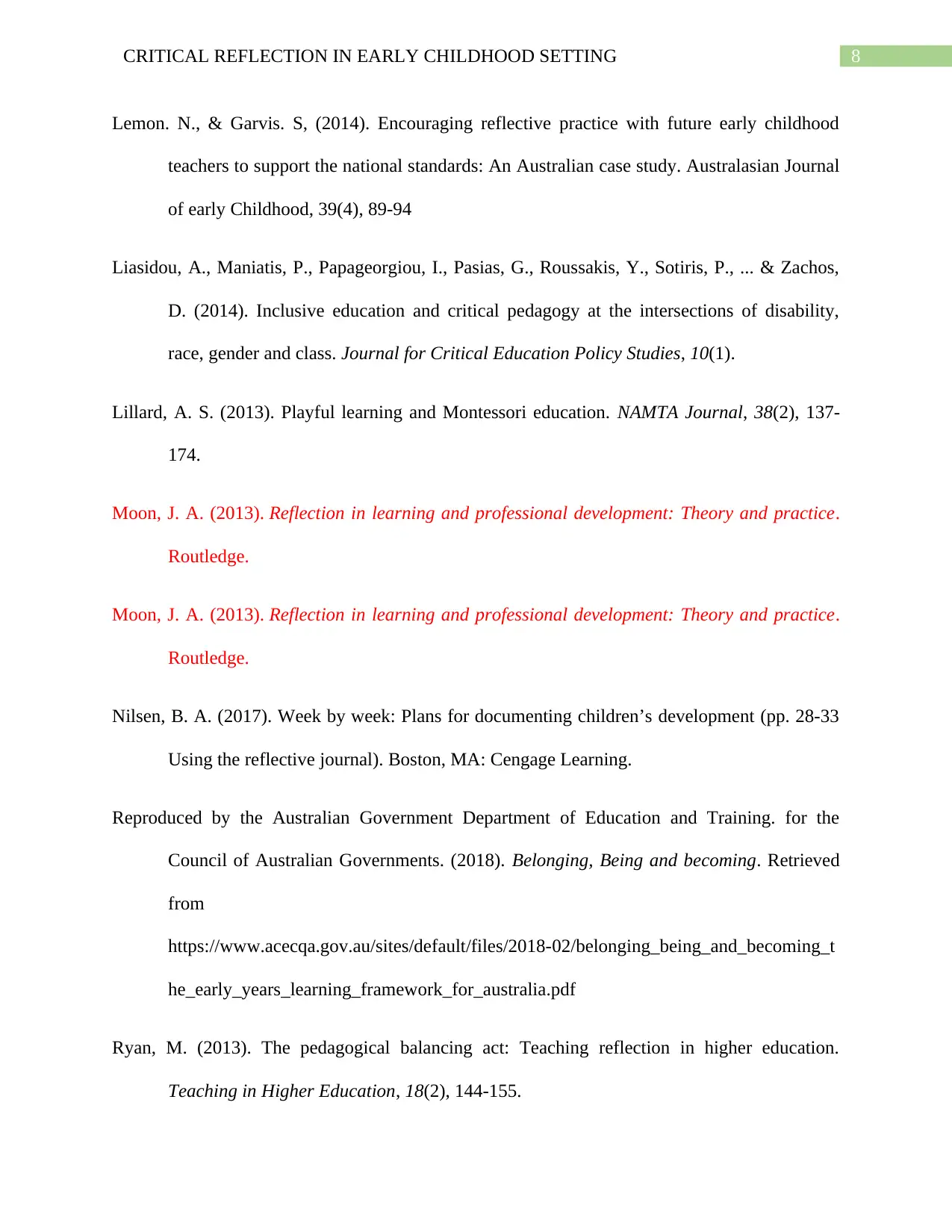
8CRITICAL REFLECTION IN EARLY CHILDHOOD SETTING
Lemon. N., & Garvis. S, (2014). Encouraging reflective practice with future early childhood
teachers to support the national standards: An Australian case study. Australasian Journal
of early Childhood, 39(4), 89-94
Liasidou, A., Maniatis, P., Papageorgiou, I., Pasias, G., Roussakis, Y., Sotiris, P., ... & Zachos,
D. (2014). Inclusive education and critical pedagogy at the intersections of disability,
race, gender and class. Journal for Critical Education Policy Studies, 10(1).
Lillard, A. S. (2013). Playful learning and Montessori education. NAMTA Journal, 38(2), 137-
174.
Moon, J. A. (2013). Reflection in learning and professional development: Theory and practice.
Routledge.
Moon, J. A. (2013). Reflection in learning and professional development: Theory and practice.
Routledge.
Nilsen, B. A. (2017). Week by week: Plans for documenting children’s development (pp. 28-33
Using the reflective journal). Boston, MA: Cengage Learning.
Reproduced by the Australian Government Department of Education and Training. for the
Council of Australian Governments. (2018). Belonging, Being and becoming. Retrieved
from
https://www.acecqa.gov.au/sites/default/files/2018-02/belonging_being_and_becoming_t
he_early_years_learning_framework_for_australia.pdf
Ryan, M. (2013). The pedagogical balancing act: Teaching reflection in higher education.
Teaching in Higher Education, 18(2), 144-155.
Lemon. N., & Garvis. S, (2014). Encouraging reflective practice with future early childhood
teachers to support the national standards: An Australian case study. Australasian Journal
of early Childhood, 39(4), 89-94
Liasidou, A., Maniatis, P., Papageorgiou, I., Pasias, G., Roussakis, Y., Sotiris, P., ... & Zachos,
D. (2014). Inclusive education and critical pedagogy at the intersections of disability,
race, gender and class. Journal for Critical Education Policy Studies, 10(1).
Lillard, A. S. (2013). Playful learning and Montessori education. NAMTA Journal, 38(2), 137-
174.
Moon, J. A. (2013). Reflection in learning and professional development: Theory and practice.
Routledge.
Moon, J. A. (2013). Reflection in learning and professional development: Theory and practice.
Routledge.
Nilsen, B. A. (2017). Week by week: Plans for documenting children’s development (pp. 28-33
Using the reflective journal). Boston, MA: Cengage Learning.
Reproduced by the Australian Government Department of Education and Training. for the
Council of Australian Governments. (2018). Belonging, Being and becoming. Retrieved
from
https://www.acecqa.gov.au/sites/default/files/2018-02/belonging_being_and_becoming_t
he_early_years_learning_framework_for_australia.pdf
Ryan, M. (2013). The pedagogical balancing act: Teaching reflection in higher education.
Teaching in Higher Education, 18(2), 144-155.
⊘ This is a preview!⊘
Do you want full access?
Subscribe today to unlock all pages.

Trusted by 1+ million students worldwide
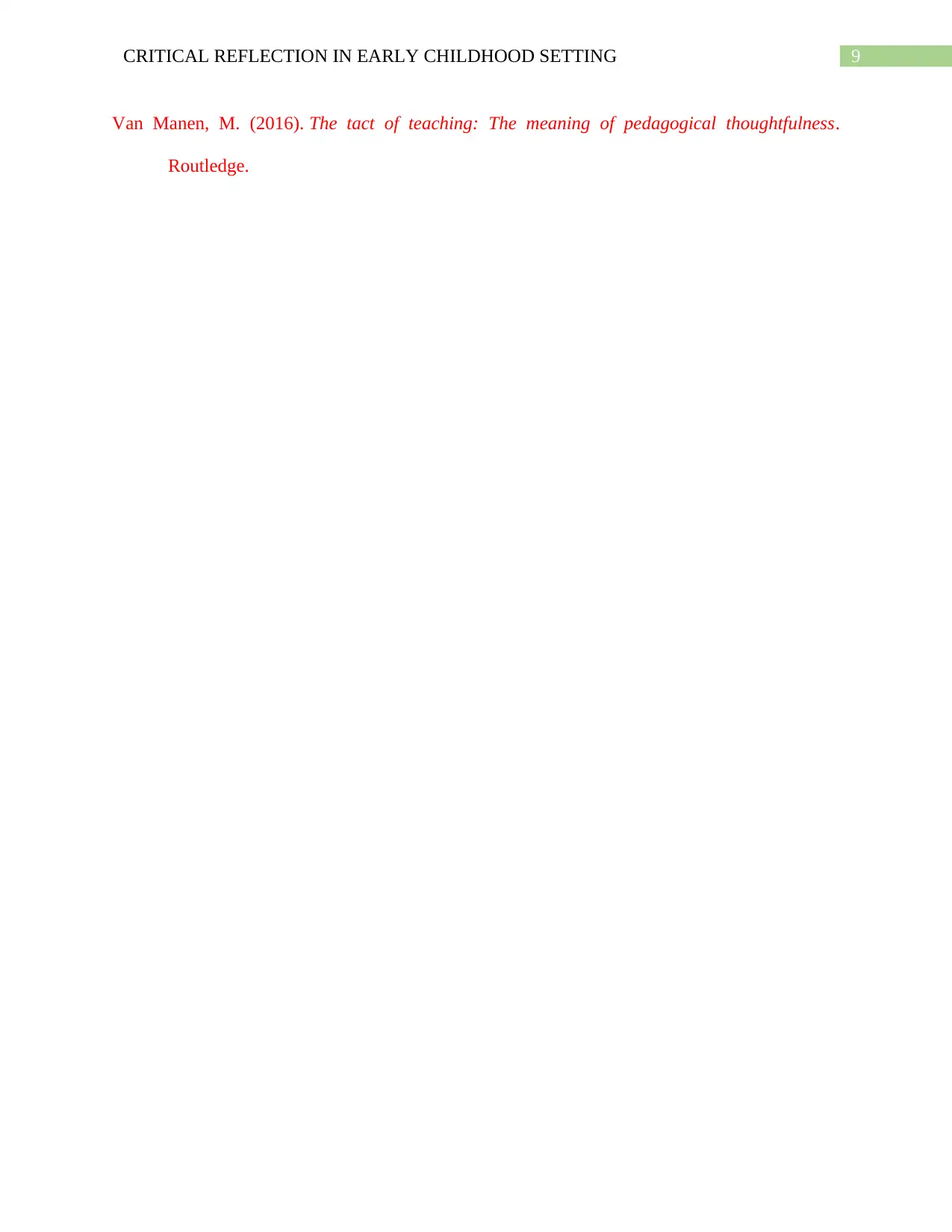
9CRITICAL REFLECTION IN EARLY CHILDHOOD SETTING
Van Manen, M. (2016). The tact of teaching: The meaning of pedagogical thoughtfulness.
Routledge.
Van Manen, M. (2016). The tact of teaching: The meaning of pedagogical thoughtfulness.
Routledge.
1 out of 10
Related Documents
Your All-in-One AI-Powered Toolkit for Academic Success.
+13062052269
info@desklib.com
Available 24*7 on WhatsApp / Email
![[object Object]](/_next/static/media/star-bottom.7253800d.svg)
Unlock your academic potential
Copyright © 2020–2025 A2Z Services. All Rights Reserved. Developed and managed by ZUCOL.





